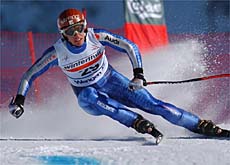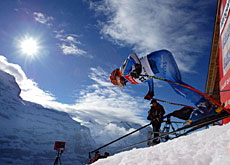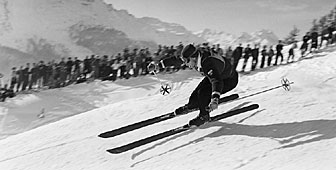The race that leaves the competition standing

Last weekend saw the 75th anniversary of the classic Lauberhorn races in the Swiss alpine resort of Wengen.
Six-time Lauberhorn champion and local legend, Karl Molitor, takes swissinfo readers through the longest piste on the World Cup circuit.
The downhill, slalom and, for the first time, a super combined event have long become early-year fixtures in the skiing World Cup and an important contributor to the local economy.
“The Lauberhorn downhill and the Streif [in Kitzbühel, Austria] are as God intended them,” grins 85-year old Molitor.
All the other races in the World Cup circuit are manufactured and pale in comparison with those two classic races, he added.
“The passages at the Brüggli corner or the Wasserstation tunnel under the famous cog railway tracks might no longer be in line with today’s standards, but they make this race so special,” Molitor said.
Oldest and longest
The 4.2km Lauberhorn downhill is the oldest and longest course of the World Cup calendar and features technically difficult sections and long gliding passages.
The race was first organised by Ernst Gertsch in 1930 and ran uninterrupted during the Second World War, when Molitor himself clinched four of his six downhill titles at the Lauberhorn.
Defying his age, Molitor still skis down the course, albeit in his own time. He also works in his son’s sports shop in Wengen.
Back in 1939 he won his first race almost ten seconds ahead of his competitors despite a fall just before the finish line.
“The jump at the Hundschopf turn [a corridor between two jutting rocks] against the backdrop of the Eiger, Mönch and Jungfrau mountains is simply unique,” he said.
Lower down on the racetrack is the “Österreicherloch” (Austrian hole) named after a series of falls by racers from neighbouring Austria in 1954.
“This is one of the few spots that was smoothed out mechanically,” Molitor explains.
Legs on fire
The final S-turn with a spectacularly difficult set of sharp curves is seen as one of the most difficult spots of the whole course.
“You can lose everything or win everything in the finish area with your legs on fire after racing down for more than two minutes,” Molitor points out.
Finally there is always an unwelcome warm wind to reckon with at the Lauberhorn. The “Guggiföhn”, as the locals call it, melts the snow and causes no end of despair for the race’s organisers.
Molitor is just one of a series of heroes of the Lauberhorn race. Austria’s Toni Sailer and Karl Schranz, Frenchman Jean-Claude Killy, and Switzerland’s Peter Müller became famous in Wengen.
Oddly enough though, Swiss racers cannot boast an impressive record at the Lauberhorn. They went without a single title between 1950 and 1974.
Two years ago Bruno Kernen became only the second Swiss in the past ten years to win the demanding race.
The low point in the history of the Lauberhorn race was the death of Austria’s Gernot Reinstadler in a qualifying race in 1991.
Boost for economy
The annual race at the Lauberhorn attracts about 40,000 people to Wengen over the three days.
The event is estimated to provide sales of nearly SFr9 million ($7.7 million) for hotels, restaurants, souvenir shops and the local railway.
It also generates an additional 30,000 overnight stays in the region.
Live television coverage of the race regularly attracts more than one million viewers.
swissinfo
Karl Molitor is the record winner of the Lauberhorn races picking up a total of 11 titles, including six downhill trophies.
Bruno Kernen was the latest Swiss winner of the downhill event in 2003.
The Lauberhorn classic is the oldest and longest downhill race in the World Cup circuit.

In compliance with the JTI standards
More: SWI swissinfo.ch certified by the Journalism Trust Initiative











You can find an overview of ongoing debates with our journalists here . Please join us!
If you want to start a conversation about a topic raised in this article or want to report factual errors, email us at english@swissinfo.ch.